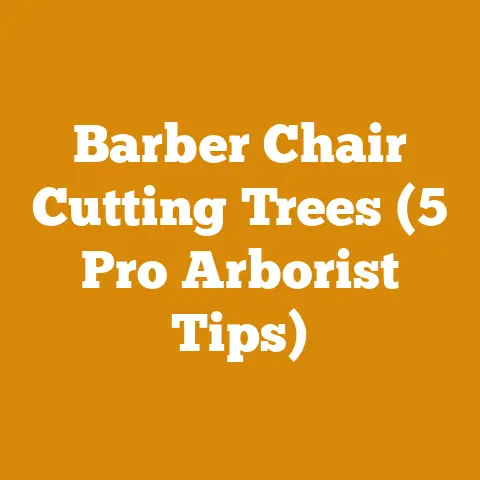Coppiced Trees for Firewood (6 Proven Species to Maximize Yield)
Let’s dive into the world of coppiced trees and unlock their potential for firewood production!
Coppiced Trees for Firewood: 6 Proven Species to Maximize Yield
Innovation in the world of firewood? You might scoff. After all, we’re talking about cutting wood, splitting it, and burning it – a practice as old as humanity itself. But trust me, even in this seemingly ancient craft, there’s always room for improvement, optimization, and a deeper understanding of the resources we use. I’ve seen it firsthand, from the woods of New England to the forests of Europe, and the one constant is that those who innovate are the ones who thrive.
That’s where coppicing comes in. It’s an ancient woodland management technique that, when applied strategically, can significantly boost your firewood yield and provide a sustainable source of fuel for years to come. It’s not just about chopping down trees; it’s about working with the trees, understanding their growth habits, and using their natural resilience to your advantage.
I remember the first time I heard about coppicing. I was working with an old logger in Maine, a guy who knew the woods like the back of his hand. He was showing me how to identify different tree species, and he pointed out a stand of what looked like multi-stemmed shrubs. “Those are coppiced trees,” he said. “Been cut back repeatedly, but they keep coming back stronger.”
At the time, I didn’t fully grasp the potential. But as I learned more about woodland management and sustainable forestry, I realized that coppicing is a powerful tool for anyone looking to produce firewood efficiently and responsibly.
What is Coppicing?
Coppicing is a traditional woodland management technique that involves cutting trees near ground level, stimulating them to produce new shoots from the stump or root system. These shoots, known as “coppice growth,” grow rapidly and can be harvested on a cyclical basis, providing a sustainable source of timber and firewood.
Think of it like pruning a shrub in your garden. When you cut back a shrub, it responds by sending out new shoots, often resulting in bushier, more vigorous growth. Coppicing works on the same principle, but on a larger scale.
The key to successful coppicing is choosing the right tree species. Some species are naturally better at regenerating from the stump than others. The six species I’ll be discussing in this article are all known for their excellent coppicing ability and their suitability for firewood production.
Why Coppice for Firewood?
There are several compelling reasons to consider coppicing for firewood:
- Sustainability: Coppicing is a sustainable practice that allows you to harvest wood without killing the tree. This ensures a continuous supply of firewood for years to come.
- Increased Yield: Coppiced trees often produce more wood per acre than trees that are allowed to grow to full maturity. This is because the coppice growth is concentrated on producing new shoots, rather than growing a large trunk and branches. Data from the UK Forestry Commission shows that coppiced woodlands can produce up to 4 times the volume of timber compared to unmanaged woodlands over a rotation period.
- Faster Growth: Coppice growth tends to be faster than the growth of new seedlings. This means you can harvest firewood more frequently, typically on a rotation of 7-20 years, depending on the species and your desired wood size.
- Improved Woodland Health: Coppicing can help to improve the health and biodiversity of your woodland. The open canopy created by coppicing allows more sunlight to reach the forest floor, which benefits a wide range of plants and animals.
- Reduced Labor: While the initial cut requires effort, the subsequent harvests are often easier and faster than felling mature trees. The coppice growth is typically smaller in diameter and easier to handle.
- Economic Benefits: For small-scale firewood producers, coppicing can provide a reliable source of income. By managing your woodland sustainably, you can ensure a consistent supply of firewood to sell.
6 Proven Species for Coppicing Firewood
Now, let’s get to the heart of the matter: the six tree species that will maximize your firewood yield through coppicing. I’ve selected these species based on their coppicing ability, growth rate, wood quality, and availability in different regions.
1. Sweet Chestnut (Castanea sativa)
Sweet Chestnut is a top choice for coppicing firewood, particularly in Europe and North America.
- Coppicing Ability: Sweet Chestnut is an excellent coppicer, producing vigorous shoots from the stump. It can be coppiced repeatedly for centuries.
- Growth Rate: Sweet Chestnut grows rapidly, especially in its early years. Coppice shoots can reach a diameter of 6-8 inches in 10-15 years.
- Wood Quality: Sweet Chestnut produces a medium-density wood that is easy to split and burns well. It has a relatively low moisture content, which means it seasons quickly. Its heat output is around 20 million BTU per cord.
- Availability: Sweet Chestnut is widely available in Europe and is becoming increasingly popular in North America.
- My Experience: I’ve worked with Sweet Chestnut in several coppiced woodlands in the UK. The trees respond incredibly well to cutting, producing dense clusters of shoots. The wood is also a pleasure to work with – easy to split and quick to dry.
- Unique Insight: Sweet Chestnut wood contains tannins, which make it naturally resistant to decay. This makes it a good choice for outdoor projects, such as fencing and posts, in addition to firewood.
- Case Study: A study conducted by the University of Exeter found that coppiced Sweet Chestnut woodlands in the UK produced an average of 8-10 cubic meters of timber per hectare per year, significantly higher than the yield from unmanaged woodlands.
2. Hazel (Corylus avellana)
Hazel is another excellent choice for coppicing firewood, especially in cooler climates.
- Coppicing Ability: Hazel coppices readily, producing numerous shoots from the base of the tree.
- Growth Rate: Hazel grows relatively quickly, with coppice shoots reaching a diameter of 4-6 inches in 7-10 years.
- Wood Quality: Hazel produces a dense, hard wood that burns hot and long. It has a heat output of around 22 million BTU per cord.
- Availability: Hazel is widely distributed throughout Europe and North America.
- My Experience: I’ve used Hazel firewood extensively in my own wood-burning stove. It produces a steady, intense heat and leaves very little ash. It’s also relatively easy to split, although the smaller diameter pieces can be a bit challenging.
- Unique Insight: Hazel is often coppiced in combination with other tree species, such as Oak or Ash, to create a diverse and productive woodland. The Hazel provides a quick return on investment, while the slower-growing species provide a long-term timber crop.
- Case Study: In Ireland, Hazel coppicing has been practiced for centuries. Traditional Hazel coppice management involves cutting the trees on a 7-year rotation, producing a sustainable supply of firewood and other woodland products.
3. Willow (Salix spp.)
Willow is a fast-growing species that is well-suited to coppicing in wet or damp areas.
- Coppicing Ability: Willow coppices extremely well, producing numerous shoots from the stump.
- Growth Rate: Willow is one of the fastest-growing tree species, with coppice shoots reaching a diameter of 4-6 inches in just 3-5 years.
- Wood Quality: Willow produces a relatively soft wood that burns quickly. It has a lower heat output than other species, around 15 million BTU per cord. However, it is easy to ignite and produces a clean flame.
- Availability: Willow is widely distributed throughout the world, especially in wet or damp areas.
- My Experience: I’ve used Willow firewood in outdoor fire pits and for kindling. It’s easy to light and produces a cheerful flame. However, it doesn’t last as long as other hardwoods, so it’s best used in combination with a slower-burning species.
- Unique Insight: Willow is often used for basket making and other crafts. The flexible shoots are ideal for weaving.
- Case Study: In Sweden, Willow coppicing is used to produce biomass for energy generation. Fast-growing Willow varieties are planted in short-rotation coppice systems and harvested every 3-5 years.
4. Poplar (Populus spp.)
Poplar is another fast-growing species that is suitable for coppicing in a variety of climates.
- Coppicing Ability: Poplar coppices readily, producing vigorous shoots from the stump.
- Growth Rate: Poplar grows quickly, with coppice shoots reaching a diameter of 6-8 inches in 5-7 years.
- Wood Quality: Poplar produces a relatively soft wood that burns quickly. It has a lower heat output than other species, around 17 million BTU per cord. However, it is easy to split and dries quickly.
- Availability: Poplar is widely distributed throughout the world.
- My Experience: I’ve used Poplar firewood in outdoor boilers and for heating workshops. It’s a good choice for situations where you need a quick burst of heat. However, it’s not ideal for long-lasting fires.
- Unique Insight: Poplar is often used for pulpwood production. The fast growth rate and high fiber content make it a valuable resource for the paper industry.
- Case Study: In the Pacific Northwest of the United States, Poplar plantations are used to produce biomass for energy generation. The trees are coppiced on a short rotation, providing a sustainable source of fuel.
5. Ash (Fraxinus excelsior)
Ash is a popular choice for firewood due to its high heat output and clean burning properties.
- Coppicing Ability: Ash coppices well, producing strong, straight shoots from the stump.
- Growth Rate: Ash grows at a moderate rate, with coppice shoots reaching a diameter of 6-8 inches in 10-15 years.
- Wood Quality: Ash produces a dense, hard wood that burns hot and long. It has a heat output of around 24 million BTU per cord. It also splits easily and seasons well.
- Availability: Ash is widely distributed throughout Europe and North America. However, it is currently under threat from Ash dieback disease, which is causing widespread mortality.
- My Experience: I’ve used Ash firewood for many years and have always been impressed by its heat output and clean burning properties. It’s one of my favorite woods to burn.
- Unique Insight: Ash is often used for tool handles and sports equipment due to its strength and flexibility.
- Case Study: Traditional Ash coppice management in the UK involves cutting the trees on a 15-year rotation, producing a sustainable supply of firewood, tool handles, and other woodland products. However, due to Ash dieback, many coppice woodlands are now being replanted with alternative species.
6. Hornbeam (Carpinus betulus)
Hornbeam, also known as Ironwood, is a dense, slow-growing species that produces excellent firewood.
- Coppicing Ability: Hornbeam coppices well, producing numerous shoots from the base of the tree.
- Growth Rate: Hornbeam grows slowly, with coppice shoots reaching a diameter of 4-6 inches in 15-20 years.
- Wood Quality: Hornbeam produces a very dense, hard wood that burns hot and long. It has a heat output of around 27 million BTU per cord, making it one of the best firewood species. It is also relatively easy to split, despite its density.
- Availability: Hornbeam is native to Europe and is also grown in North America.
- My Experience: I’ve used Hornbeam firewood in my wood-burning stove on cold winter nights. It produces a steady, intense heat that lasts for hours. It’s also a beautiful wood with a distinctive grain pattern.
- Unique Insight: Hornbeam is often used for hedges and topiary due to its dense foliage and ability to withstand pruning.
- Case Study: In Germany, Hornbeam coppice management is used to produce high-quality firewood for domestic heating. The slow growth rate means that the trees are coppiced on a longer rotation, typically 20-25 years.
Coppicing Techniques: A Step-by-Step Guide
Now that you know which species to choose, let’s talk about the techniques involved in coppicing.
- Planning: Before you start coppicing, it’s important to plan your approach. Consider the age and health of your trees, the desired size of your firewood, and the overall goals for your woodland.
- Timing: The best time to coppice is during the dormant season, typically in late winter or early spring, before the trees start to produce new growth. This minimizes stress on the trees and allows them to focus their energy on producing new shoots.
- Cutting: Use a sharp saw or axe to cut the trees as close to the ground as possible. Angle the cut slightly downwards to prevent water from pooling on the stump.
- Stump Management: Remove any loose bark or debris from the stump to prevent rot. You can also apply a sealant to the cut surface to protect it from infection.
- Shoot Selection: As the coppice shoots begin to grow, you may need to thin them out to promote the growth of the strongest shoots. Remove any weak or damaged shoots, leaving the healthiest and most vigorous ones.
- Protection: Protect the coppice growth from grazing animals, such as deer or rabbits, by fencing or using tree guards.
- Monitoring: Monitor the coppice growth regularly to ensure that the trees are healthy and growing well.
Tools of the Trade
Having the right tools is essential for successful coppicing. Here are some of the tools I recommend:
- Chainsaw: A chainsaw is essential for felling larger trees. Choose a model that is appropriate for the size of the trees you will be cutting. I recommend a Stihl or Husqvarna chainsaw for their reliability and performance. I personally use a Stihl MS 261 C-M for most of my firewood work. It’s powerful enough to handle most trees, but light enough to use for extended periods.
- Axe: An axe is useful for felling smaller trees and splitting firewood. Choose an axe with a sharp blade and a comfortable handle. A splitting axe with a maul is ideal for larger rounds.
- Bow Saw: A bow saw is a lightweight and versatile tool for cutting smaller branches and coppice shoots.
- Pruning Shears: Pruning shears are useful for thinning out coppice shoots and removing any unwanted growth.
- Safety Gear: Always wear appropriate safety gear when coppicing, including a helmet, eye protection, ear protection, gloves, and sturdy boots.
Safety First: Coppicing Best Practices
Safety should always be your top priority when coppicing. Here are some best practices to follow:
- Assess the Risks: Before you start coppicing, take the time to assess the risks involved. Identify any potential hazards, such as falling branches, unstable trees, or slippery terrain.
- Wear Appropriate Safety Gear: As mentioned earlier, always wear appropriate safety gear, including a helmet, eye protection, ear protection, gloves, and sturdy boots.
- Work with a Partner: It’s always a good idea to work with a partner when coppicing, especially if you are felling larger trees. Your partner can help to spot hazards and provide assistance if needed.
- Use Proper Techniques: Use proper techniques for felling trees and splitting firewood. If you are unsure how to do something safely, seek advice from an experienced logger or arborist.
- Take Breaks: Coppicing can be physically demanding work. Take regular breaks to avoid fatigue and prevent injuries.
- Be Aware of Your Surroundings: Be aware of your surroundings at all times. Watch out for falling branches, wildlife, and other potential hazards.
Challenges and Considerations
While coppicing offers many benefits, there are also some challenges and considerations to keep in mind:
- Labor Intensive: Coppicing can be labor intensive, especially if you are managing a large woodland.
- Time Commitment: Coppicing requires a long-term commitment. You need to be prepared to manage your woodland on a cyclical basis for many years.
- Market Fluctuations: The demand for firewood can fluctuate depending on weather conditions and economic factors. This can affect your income if you are selling firewood.
- Regulations: Be aware of any local regulations or restrictions on coppicing. In some areas, you may need to obtain a permit before you can start coppicing.
- Pest and Diseases: Be aware of potential pests and diseases that can affect your trees. Monitor your woodland regularly and take appropriate action if you detect any problems. As mentioned earlier, Ash dieback is a major threat to Ash trees in Europe and North America.
Conclusion: Coppicing – A Sustainable Path to Firewood Abundance
Coppicing is a powerful and sustainable way to produce firewood. By choosing the right tree species and using proper techniques, you can maximize your yield and ensure a continuous supply of fuel for years to come.
I’ve shared my experiences, insights, and practical tips in this article to help you get started. Remember to prioritize safety, plan your approach carefully, and monitor your woodland regularly.
Whether you’re a hobbyist looking to heat your home or a small-scale firewood producer looking to generate income, coppicing offers a rewarding and sustainable path to firewood abundance. So, get out there, connect with your woodland, and start coppicing! You might just be surprised at how much wood you can produce. And remember, innovation, even in the ancient art of firewood preparation, is the key to long-term success.






